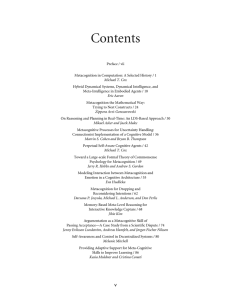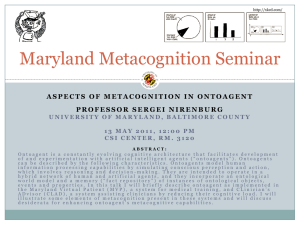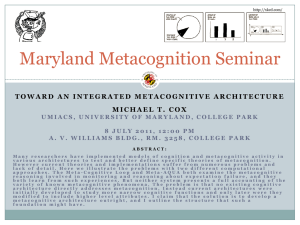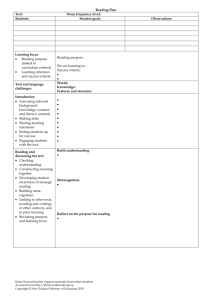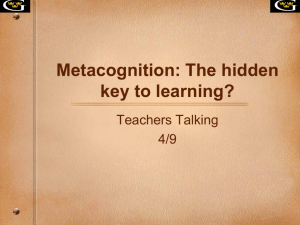Metacognition as Kludge Peter Carruthers with thanks to
advertisement
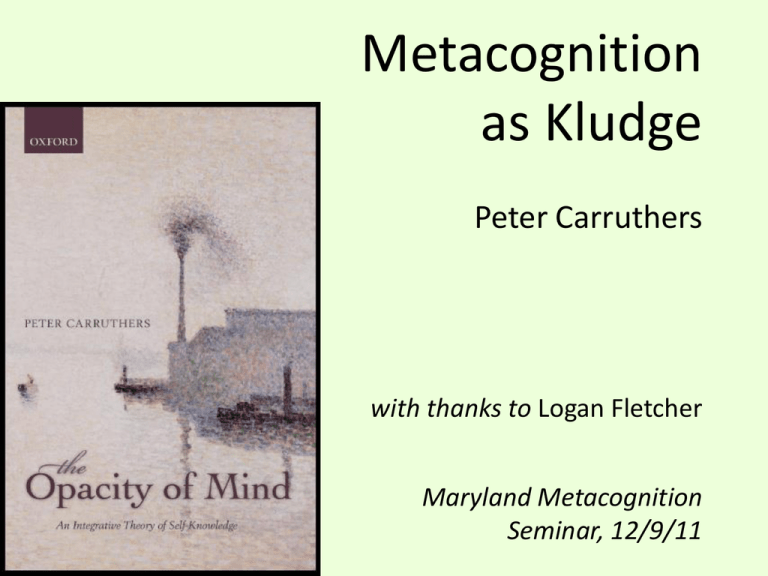
Metacognition as Kludge Peter Carruthers with thanks to Logan Fletcher Maryland Metacognition Seminar, 12/9/11 Outline 1. 2. 3. 4. 5. The theses The meaning of “metacognition” Metacognition of knowledge & learning System 1 & System 2 Metacognition of reasoning & decision making 6. Conclusion 2 The theses 1. There is no adaptation for metacognition, but rather 1st-person use of mindreading faculty. 2. Metacognitive skills vary widely among people, depend on individual learning, and are generally not very effective. 3. Metacognitive monitoring is sensory-cue based, not direct. 4. Metacognitive interventions aren’t direct, but depend on indirect behavioral and attentional influence. 3 The Meaning of “Metacognition” • Metacognition involves self-directed metarepresentation • (either conceptual or nonconceptual). • This is what psychologists mean – “thinking about [one’s own] thinking”. • Some in cog. sci. seem to mean only: influencing or controlling a cognitive process. • No quarrel. • There are multiple monitoring-and-control processes of a non-metarepresentational sort. 4 Monitoring and Control of Action 5 Metacog of knowledge & learning • Judgments of memory and learning are cuebased – • Memory: ease of access of fragments of target or items related to target. • Learning: fluency with which items are processed (e.g. fonts, time studying). • Not what one would predict if metacognition evolved for purposes of cognitive control. • One shouldn’t need to rely on indirect cues. 6 Metacog of knowledge & learning • Intention to learn has an effect on study patterns • but no effect on learning & recall with study patterns controlled for. • Most meta-learning strategies are behavioral • focusing of attention, mental rehearsal, etc. • Strategies are modestly effective at best; not a robust native competence. • More likely: guided by mindreading faculty in the absence of direct access to the process. 7 Metacog of knowledge & learning • • • • • • fMRI: metacognition = mindreading. Some studies contrast within metacognition. FOK vs TOT; past vs future-directed confidence using “don’t know” for contrast with both. But this is metacognitive too! Chua et al. (2006, 2009) contrast confidence and metamemory with first-order recognition. • Medial prefrontal, posterior cingulate, temporo-parietal junction. 8 System 1 & System 2 • In order to explain patterns of response to reasoning tasks • and to explain individual differences • many postulate dual systems: • System 1 (intuitive) and System 2 (reflective). • Even those who get answers right still feel the “pull” of intuitive but incorrect response. • System 2 is supposed to monitor output of System 1, intervening where needed. 9 System 1 & System 2 • System 1 (“intuitive”) – is fast, parallel, unconscious; • isn’t easily altered; is universal; • is impervious to verbal instruction; • is (partly) heuristic based; • is (mostly) shared with other animals. • Note: only the inputs and outputs of System 1 are available for monitoring by mindreading. Evidence of any other form of monitoring is evidence of an adaptation for metacognition. 10 System 1 & System 2 • System 2 (“reflective”) – is slow, serial, conscious; • malleable; variable (by culture and individual); • responsive to verbal instruction; • influenced by normative belief; • can involve application of valid rules. • Note: System 2 processes are available for monitoring by mindreading. Evidence of native competence is needed to support adaptation for metacognition. 11 System 1 & System 2 • System 1 doesn’t depend on working memory. • System 2 does. • An executively controlled system that can call up and manipulate stored information. • The cognitive basis of g - general intelligence. • Plus disposition to reflect. • Plus knowledge of reasoning rules and strategies. 12 System 1 & System 2 • Monitoring of System 2 is sensory-cue-based • visuo-spatial, inner speech, etc. • Working memory uses executive resources to direct and focus attention • calling up and manipulating conceptualized sensory representations • exapting the “global broadcast” of attended sensory information (Baars). Monitoring can be done by the mindreading faculty. 13 Metacognition of reasoning • No natural competence to intervene in and improve our own System 2 reasoning. • People are generally bad at reasoning about reasoning. • Emerges late in development. • Dependent upon culture and formal education. • Not what one would predict if there were an adaptation for metacognition. 14 Metacognition of reasoning • Monitoring of System 1 output leads to System 2 processing? • In some people – large individual variation. • Most seem not to employ System 2 at all. • Large variation in “mindware” – the reasoning rules appealed to in System 2. • Variation in factors triggering System 2 – • for some, disfluency; for others, contentdependent habits; etc. No evidence of adaptation for the purpose. 15 Metacognition of affect • Monitoring for affective influence on judgment isn’t routine – weather & happiness • mood induction & judgments of risk. • Attention needs to be called to possible sources of affect. • For some people, drawing attention to affect makes the influence bigger, not smaller. • Capacities to discount incidental affect vary • often depend on folk knowledge. 16 Metacognition of decision making • Willpower: the marshmallow test (Mischel). • Need to monitor affect and imminent action & intervene. • Intelligent direction of attention. • Widely varying strategies: • look away; sit on hands; play with another object; sing songs to oneself; etc. Metacognition is a cobbled-together skill. 17 Conclusions • No evidence that metacognitive monitoring is direct. o Rather, self-directed mindreading relying on sensorily-accessible cues. • No evidence of a native competence for metacognition. o Rather, individual and cultural learning. Metacognition is a kludge. 18
